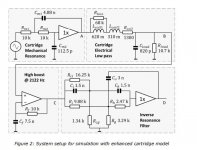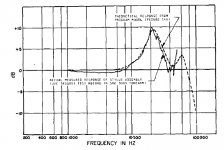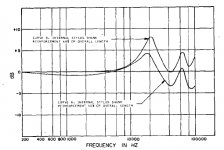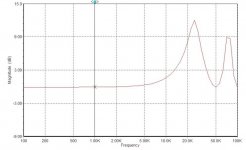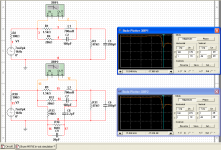Very interesting. I notice you don't have the self inductance in your model.
If I get any time will try and work out what is the difference in the behaviour of the mechanical model you tried with the van Raalte model
If I get any time will try and work out what is the difference in the behaviour of the mechanical model you tried with the van Raalte model
Attachments
Last edited:
Very interesting. I notice you don't have the self inductance in your model.
Yes it's there, but my bad I'd picked up the wrong schematic for the model, so edited my post to include the correct one.
The correct model schematic (basic) is here :
http://www.diyaudio.com/forums/atta...nical-resonance-mms-tl-20full-20schematic.jpg
And it really is as simple as that !
LD
The main difference is vR's model is a classic 2nd order resonant system, which has a monotonic resonance. Whereas the TL model differs in that it yields a series of resonances and lacks a roll-off.If I get any time will try and work out what is the difference in the behaviour of the mechanical model you tried with the van Raalte model
IMO the TL model better describes observed measurements, especially at ultrasonic hf. Here's an extract from a Happ/Shibata paper as to mechanical response, which is a good match for the first few peaks/troughs predicted from my TL model (also attached). It would be tough to explain in vR's model I think.
When discussing mechanical resonance, sooner or later one has to square up to the fundamental question of whether it arises from cantilever self-resonance, or from tip-mass/vinyl spring. There's no sitting on the fence because it can't be both ! I strongly prefer the TL cantilever self resonance, even though pretty much the whole industry believed in the tip-mass/spring model - even George's linked B&K paper merrily passed off the odd ultrasonic discrepancies as due to vinyl compliance. More likely TL artifacts associated with cantilever flex, IMO, a much better fit.
LD
Attachments
Last edited:
Very interesting. I notice you don't have the self inductance in your model.
If I get any time will try and work out what is the difference in the behaviour of the mechanical model you tried with the van Raalte model
I have this article from LAv3,
do you know where to put this circuit inside RIAA preamp?
Anwhere you want to! I am planning (if I need it) to put in in miniDSP. The SvR method is load the cart down to give you a first order roll off from 2kHz (noting Cordell says that gives a noise penalty), then LF correction then anti-resonance.
aha...
would you show block schematic?
Anwhere you want to! I am planning (if I need it) to put in in miniDSP.
Except..........if the resonance arises from cantilever flex effects, the system you are correcting for isn't minimum phase, which might matter. Nor does it have a high order ultrasonic roll-off (which prob doesn't matter). AFAIK, hf audio cues for arrival time matter.
Uninstinctively, in mechanical TLs, propagation velocity varies significantly with frequency. This is a property of all cantilevers, if they flex, and is probably a part of vinyl sound at hf, I think.
The DSP is a good vehicle, once the system one is correcting for is understood is my point. It's not just about f response........perhaps.
LD
Agreed. And why I started this thread. I would never expect total correction, not least because I think there will be level related effects as well but some time domain correction could be useful.
Pawel: Might help if you explain what you are planning, as my setup will end up a bit non-standard.
Pawel: Might help if you explain what you are planning, as my setup will end up a bit non-standard.
Pawel: Might help if you explain what you are planning, as my setup will end up a bit non-standard.
I would like to build MM pre like from those NL articles from coherentsound but need a formula how to calculate R1 to get right cooling and correction decaying.
The basic model has a lossless TL, whereas in reality there are losses, as there are in the generator. Easy enough to add to the model - try it !
I spent a happy few months a few years back playing about with models for Ortofon and AT carts, but also did a SaS/Shure V15 which I'll try to find. I rapidly became certain this model can mimic reality very well, so much so that it probably is what is really going on IMO.
Interesting?
LD
Yes! As usual you're the man. Where does the vinyl compliance come into play if at all?
When discussing mechanical resonance, sooner or later one has to square up to the fundamental question of whether it arises from cantilever self-resonance, or from tip-mass/vinyl spring. There's no sitting on the fence because it can't be both ! I strongly prefer the TL cantilever self resonance, even though pretty much the whole industry believed in the tip-mass/spring model - even George's linked B&K paper merrily passed off the odd ultrasonic discrepancies as due to vinyl compliance. More likely TL artifacts associated with cantilever flex, IMO, a much better fit.
Hi Lucky
For the tip mass-vinyl compliance interaction and the mechanical model, see Fig. 4, Fig.5 and associated text.
http://shure.custhelp.com/ci/fattach/get/29245/
George
I wonder whether, somehow, your experiment measured the self-resonance of the coil ? ie the coil's own inductance and self-capacitance in isolation ?
I think this is what the measurements show. Inevitably the short instrumentation wiring adds some to it.
The values of resistor and capacitor in parallel to the coil in the simulation are not unique and it’s one of the pairs that give a plotted result comparable to that of the measurement.
George
Attachments
I think we should nag Doug to write a book...
Except the abstract would start, "Everything you know is wrong".
Except the abstract would start, "Everything you know is wrong".
Sort of start I like
Hi George, yes if one looks at figure 4 in the Shure paper, the first thing one sees in that model is a 2-stage lumped approximation to a transmission line..........Hi Lucky
For the tip mass-vinyl compliance interaction and the mechanical model, see Fig. 4, Fig.5 and associated text.
http://shure.custhelp.com/ci/fattach/get/29245/
George
It's also worth noting that compliance Shure associate with cantilever flex, presumably to obtain results that match observations, is almost an order of magnitude bigger than they associate with vinyl compression........
Roughly, I think that model converges with a TL, even if Shure didn't realise it in those terms. Just as a lumped model can approximate a TL, of course.
The missing factor is to consider that cantilever flex means that stylus motion is not immediately conveyed to the generator at the other end: rather, vibrations propagate along the cantilever as transverse flex waves at a relatively slow velocity. Then a continuous TL model drops results which mimic reality IMO, and are also consistent with lumped approximations, of course.
LD
Last edited:
To explain observations, it's not necessary for it to happen at all IMO........ cantilever flex is sufficient per se, and energy suggests it can't happen to any meaningful extent in any event.Where does the vinyl compliance come into play if at all?
You know, that's not a bad title for a movie......!? Let's go straight to the film script? Brad Pitt ?Except the abstract would start, "Everything you know is wrong".
LD
- Home
- Source & Line
- Analogue Source
- mechanical resonance in MMs
